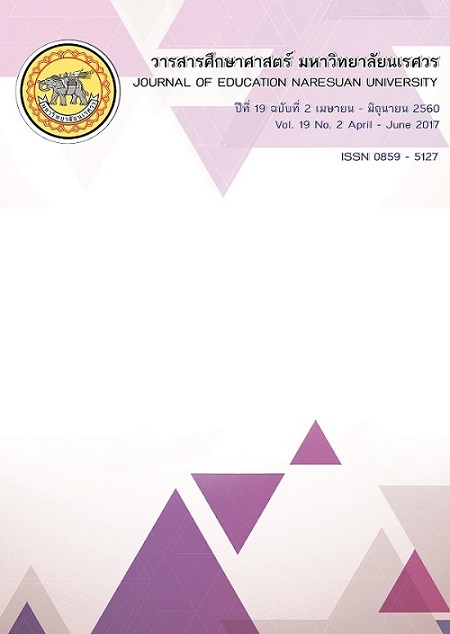การพัฒนาหลักสูตรท้องถิ่น เพื่อเสริมสร้างอัตลักษณ์สมุทรสาคร สำหรับนักเรียนชั้นมัธยมศึกษาปีที่ 3
Main Article Content
Abstract
การวิจัยครั้งนี้มีจุดมุ่งหมายของการศึกษา คือ พัฒนาหลักสูตรท้องถิ่น เพื่อเสริมสร้างอัตลักษณ์สมุทรสาคร สำหรับนักเรียนชั้นมัธยมศึกษาปีที่ 3 โดยมีขั้นตอนการวิจัย 3 ขั้นตอน คือ 1) การสร้างและตรวจสอบคุณภาพหลักสูตรท้องถิ่น เพื่อเสริมสร้างอัตลักษณ์สมุทรสาคร สำหรับนักเรียนชั้นมัธยมศึกษาปีที่ 3 2) การทดลองใช้หลักสูตรท้องถิ่น เพื่อเสริมสร้างอัตลักษณ์สมุทรสาคร สำหรับนักเรียนชั้นมัธยมศึกษาปีที่ 3 3) การประเมินหลักสูตรท้องถิ่น เพื่อเสริมสร้าง อัตลักษณ์สมุทรสาคร สำหรับนักเรียนชั้นมัธยมศึกษาปีที่ 3 ใช้แบบแผนการวิจัยแบบคู่ขนาน ซึ่งให้ความสำคัญกับวิธีเชิงปริมาณและเชิงคุณภาพ เท่าเทียมกัน โดยนำหลักสูตรที่พัฒนาขึ้นไปใช้กับกลุ่มตัวอย่างที่ได้จากการเลือกแบบเจาะจง เป็นนักเรียนชั้นมัธยมศึกษาปีที่ 3 ปีการศึกษา 2558 โรงเรียนเทศบาลวัดแหลมสุวรรณาราม (วัฒนรวมวิทยา) จำนวน 1 ห้องเรียน เครื่องมือที่ใช้ในการวิจัย ได้แก่ 1) หลักสูตรท้องถิ่นฯ 2) แบบวัดคุณลักษณะการเกิดอัตลักษณ์สมุทรสาคร 3) แบบทดสอบวัดผลสัมฤทธิ์ทางการเรียน 4) แบบสังเกตการณ์ปฏิบัติตามอัตลักษณ์สมุทรสาคร และ
5) แบบประเมินความพึงพอใจของนักเรียน การวิเคราะห์ข้อมูลใช้ค่าสถิติ ค่าร้อยละ ค่าเฉลี่ย ค่าความเบี่ยงเบนมาตรฐาน และการทดสอบค่า t (t-test dependent) ผลการวิจัย พบว่า
1. ผลการสร้างและตรวจสอบคุณภาพหลักสูตร พบว่า หลักสูตรท้องถิ่นใช้กระบวนการทางสังคม 5 ขั้นตอน ที่เน้นให้ผู้เรียนสร้างองค์ความรู้ด้วยตนเอง ตามแนวคิดการเรียนรู้ร่วมกัน เน้นกิจกรรมการฝึกปฏิบัติ มีลักษณะบูรณาการเนื้อหาสาระในท้องถิ่นเพื่อทำให้เกิดอัตลักษณ์ภายในตัวผู้เรียน หลักสูตรท้องถิ่นประกอบด้วย หลักการ จุดมุ่งหมาย โครงสร้าง สาระการเรียนรู้ สื่อการเรียนการสอน แนวการวัดและประเมินผล แล้วนำร่างหลักสูตรให้ผู้เชี่ยวชาญประเมินความเหมาะสม พบว่า หลักสูตรท้องถิ่นฯ มีความเหมาะสมในระดับมากที่สุด เมื่อนำหลักสูตรท้องถิ่นไปทดลองใช้ พบว่า นักเรียนมีความรู้ความเข้าใจอัตลักษณ์สมุทรสาครสูงกว่าก่อนพัฒนาอย่างมีนัยสำคัญทางสถิติที่ระดับ .05 และนักเรียนมีคุณลักษณะการเกิดอัตลักษณ์สมุทรสาครในระดับดีทั้งในภาพรวมและรายด้านทุกด้าน
2. ผลการทดลองใช้หลักสูตรท้องถิ่นฯ พบว่า หลังการพัฒนา นักเรียนมีความรู้ความเข้าใจอัตลักษณ์สมุทรสาคร สูงกว่าก่อนการพัฒนาอย่างมีนัยสำคัญทางสถิติที่ระดับ .05 และผลการประเมินคุณลักษณะการเกิดอัตลักษณ์สมุทรสาคร ของผู้เรียน พบว่า 1) คุณลักษณะการเกิดอัตลักษณ์สมุทรสาคร โดยภาพรวม 5 ด้าน พบว่า ในภาพรวมผู้เรียนเกิดอัตลักษณ์สมุทรสาครอยู่ในระดับดี จำนวน 82 คน คิดเป็นร้อยละ 56.60 2) ด้านตราจังหวัดสมุทรสาคร ผู้เรียนส่วนใหญ่มีผลอยู่ในระดับดี จำนวน 19 คน คิดเป็นร้อยละ 63 3) ด้านอัตลักษณ์เมืองประมง ผู้เรียนส่วนใหญ่มีผลอยู่ในระดับดีมาก จำนวน 20 คน คิดเป็นร้อยละ 67 4) ด้านอัตลักษณ์ดงโรงงาน ผู้เรียนส่วนใหญ่มีผลอยู่ในระดับดี จำนวน 14 คน คิดเป็นร้อยละ 57 5) ด้านอัตลักษณ์ลานเกษตร ผู้เรียนส่วนใหญ่มีผลอยู่ในระดับดี จำนวน 19 คน คิดเป็นร้อยละ 63 และ 6) ด้านอัตลักษณ์เขตประวัติศาสตร์ ผู้เรียนส่วนใหญ่มีผลอยู่ในระดับดี จำนวน 21 คน คิดเป็นร้อยละ 70
3. ผลการประเมินความพึงพอใจที่มีต่อการเข้าร่วมกิจกรรมตามหลักสูตร พบว่า ภาพรวมอยู่ในระดับมากที่สุด (= 4.54, S.D.= 0.43) โดยผู้เข้ารับการพัฒนาได้รับการพัฒนาพฤติกรรมที่ระบุในหลักสูตรมากที่สุด (
= 4.78, S.D. = 0.42) รองลงมาคือ กิจกรรมการอบรมได้ฝึกปฏิบัติเน้นการคิดวิเคราะห์ การเรียนรู้ด้วยตนเอง (
= 4.72, S.D. = 0.45) ตามลำดับ
LOCAL CURRICULUM DEVELOPMENT TO PROMOTE SAMUT SAKHON IDENTITY FOR MATTHAYOMSUKSA 3 STUDENTS
This thesis aimed to develop a local curriculum to promote Samut Sakhon identity for Matthayomsuksa 3 students. The research was divided into 3 steps; 1) construction and quality assessment of a local curriculum to promote Samut Sakhon identity for Matthayomsuksa 3 students, 2) trial on a local curriculum to promote Samut Sakhon identity for Matthayomsuksa 3 students, and 3) assessment of a local curriculum to promote Samut Sakhon identity for Matthayomsuksa 3 students. The research was conducted by using parallel research which equally focuses on quantity and quality. The developed curriculum was used with the sample selected by a purposive sampling method. The sample included 1 class of Matthayomsuksa 3 students from Watlaemsuwannaram Municipality School in academic year 2015. The research instruments were; 1) local curriculum, 2) characteristic assessment, 3) achievement test, 4) observational follow identities, 5) assessments of student satisfaction, and 6) data were analyzed using the statistical percentage average standard deviation and the t-test. The results can be described as follows:
1. Regarding the construction and quality assessment of the local curriculum, it was found the local curriculum use social process step 5. The study focuses on self-knowledge. Based on the concept of mutual learning. Focuses on practical training. The integration of local content to cause internal learner identities. That the local curriculum consisted of principles, structures, objectives, instructional media and guidelines for evaluation and assessment were included. Then the draft of the curriculum was assessed its appropriateness by add curriculum unique the experts. It was found that the curriculum focusing on capabilities was considered appropriate at the highest level. Regarding the trial of the local curriculum, it was found that the students had more understanding about Samut Sakhon identity at a statistical significance of .05. In addition, the students had characteristics of Samut Sakhon identity formation in a good level in overall and individual aspects.
2. Regarding the results of trial on local curriculum, it was found that after. The students taught by the local curriculum had more understanding about Samut Sakhon identity at a statistical significance of .05. Regarding the assessment of student identity formation, it was found that: 1) in overall, 5 aspects of the characteristic assessment of Samut Sakhon identity formation indicated that the students were in a good level. That is, 82 students (56.6 percent). 2) Regarding the Seals of the provinces of Samut Sakhon, most of the students were in a good level. That is, 19 the students (63 percent). 3) Regarding the Fishery Town Identity, most of the students were at an excellent level. That is, 20 students (67 percent). 4) Regarding the Factory Field Identity, most of the students were in a good level. That is, 14 students (57 percent). 5) Regarding the Agricultural Area identity, most of the students were in a good level, That is, 19 students (63 percent). And 6) regarding the Historical area identity, most of the students were in a good level. That is, 21 students (70 percent).
3. The assessment of student satisfaction towards participating activities indicated in the curriculum revealed that an overall was at the highest level (= 4.54, S.D. = 0.43), the students had developed behaviors as described in the curriculum (
= 4.78, S.D. = 0.42), and activities focusing on critical thinking and self-learning (
= 4.72, S.D. = 0.45) respectively.
Article Details
The owner of the article does not copy or violate any of its copyright. If any copyright infringement occurs or prosecution, in any case, the Editorial Board is not involved in all the rights to the owner of the article to be performed.

